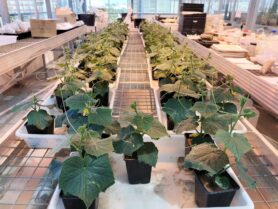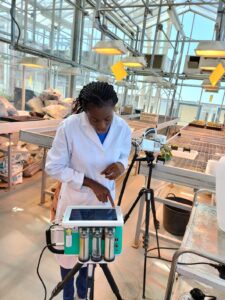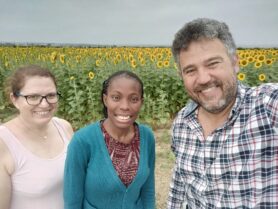Blogs
My secondment at Fertiberia – an enriching experience!
Hello there! I am Tolulope, ESR 8, hosted at the University of Sevilla, Spain. I am a Soil Scientist and Agronomist. Since I had some experience introducing new fertilizer products and working with small holder farmers in Sub Saharan Africa (SSA) before starting my PhD, I was also interested in gaining richer experience along this line in Europe. Although my non-academic secondment was supposed to be an Agricultural Firm in Bayreuth, Germany (GEOTEAM) where I would be privileged to work with farmers, however, due to certain issues, I ended up having it at the Research, Development, and Innovation (R+D+I) Unit of Fertiberia, located at the Centre for Research, Technology and Innovation (CITIUS II), University of Seville, and it was an amazing experience.
 Transplanting of cucumber into pots together with Sara Lozano. |
Fertiberia (https://www.fertiberia.com/) is a reputable fertilizer company with headquarters in Madrid, Spain and six production centres across Spain and France. It is part of the Grupo Fertiberia holding which includes ADP fertilizantes (https://www.fertiberia.com/nuestras-empresas/adp-fertilizantes/), TRICHODEX (https://www.fertiberia.com/nuestras-empresas/trichodex/bioprotectores/) or Agralia (https://www.fertiberia.com/nuestras-empresas/agralia/). The yearly production capacity of Fertiberia is about six million tonnes. The major market is in Southern Europe, North Africa, and South America. Fertiberia as a fertilizer company is into production of highest value-added and sustainable fertilizer products for agricultural production. The R+D+I Unit is saddled with the responsibility of researching and developing new products with maximum agronomic effectiveness and environmental efficiency. It was a privilege to have my secondment with this unit. The scope of my secondment with Fertiberia was well mapped out before the start. I carried out a pot trial with cucumber to test different sources of Iron which included prototype novel raw materials for mineral fertilizers. The experiment was carried out in the greenhouse facility of CITIUS II module of the University of Seville (the section used by Fertiberia). Carrying out a pot trial in the R+D+I unit of Fertiberia exposed me to the perspective of trial conditions in fertilizer industry and market which is quite different from that of academia based on the overall goal. While a trial in the academia setting might be rated perfect once it brings up something new, for the industry perspective, it goes beyond that. There are certain conditions and standards the new product must meet for it to be accepted by the fertilizer regulatory body. In the EU for example, it must be marketable, have the capacity to increase farmers yield, be accepted by farmers to mention a few. |
 A cross section of the cucumber plants in the greenhouse. |
|
 Measurements of photosynthetic activities of the cucumber plants using the IRGA equipment. |
In addition, I had the privilege to visit two field trials (Sunflower and cotton) in Southern Spain where new fertilizer products that have passed through the process of testing in the green house are currently being tested on the field in collaboration with farmers. This was an interesting experience for me as I met professionals who have been working along this line for so many years and I was able to learn from their wealth of experience. I realized that the process of discovering a new product to testing and commercialization could take as long of five to six year or even more. This is because it must pass through definite stages before it can be commercialized as a new product. For example, I realized that there are minimum number of field trials that a new product must pass through based on set conditions for validation. It must also pass all the regulatory and legalization tests by the EU after the several testing stages.Furthermore, I was opportune to visit one of the company production center in Huelva, Spain and it was a fantastic experience. I visited with some of the R+D+I staff and had a tour around one of the new demonstration fertilizer plants of the EU H2020 B-Ferst project (https://bferst.eu/) that is in the process of being finished. During the time of my secondment at Fertiberia, I was also privileged to meet and work with outstanding staff of the company like José Manuel Carpintero, the project manager (in Sevilla) who happened to be my direct supervisor; Ana Laureano, who assisted in certain ways, Cinta Cazador (project manager in Huelva), who I had been communicating with since the beginning of my project but was finally able to see in person, Sara Lozano and Francisco Requena, student interns at the time and finally Javier Brañas, the R&D director. My experience with Fertiberia was a rich one and I am glad I didn´t miss the opportunity to be exposed to such wealth of knowledge in a short time.
 Harvesting of the cucumber plants with Sara Lozano and Francisco Requena. |
 A visit to sunflower trial field with Jose Manuel Carpintero and Manuela Fernandes (ADP fertilizantes). |

